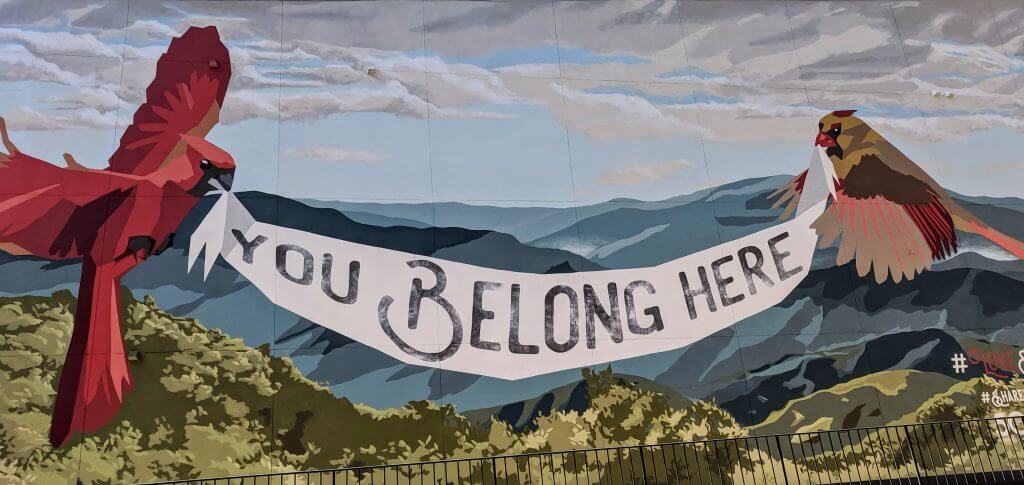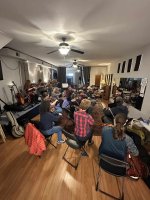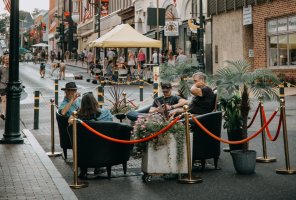
A Day in the Life of Muralist Christy Baker
There’s no way you could miss the newest addition to downtown Staunton: the “You Belong Here” mural by artist Christy Baker. Vibrant, beautiful, and meaningful, its message encourages visitors and residents alike to come to Staunton and stay awhile. We got a chance to catch up with Christy, and she’s given us all kinds of insight into her artistic process, the daily schedule of someone in her line of work, and her thoughts on public ideas about people who make a career out of the arts. Read on to meet Christy.
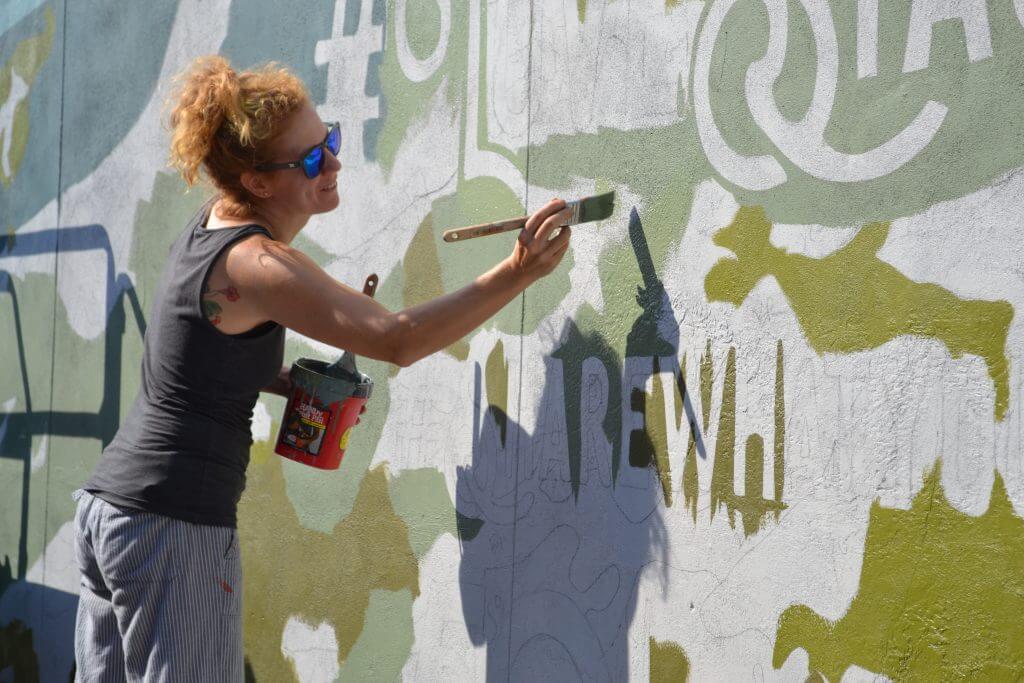
Besides creating and painting murals, what kind of work do you do?
I founded a paint company called Good Bones Paint, a DIY-friendly, one-step furniture paint. It can be found locally at Augusta Paint in Staunton as well as over 40 dealers in the Southeast.
I also started and co-own an artistic finishing business in Charlottesville. Pigment is my main focus, and we have a 2,500-square foot professional paint studio/shop where we ‘re-fab’ furniture, cabinets, offer color consultation services, and more. All of our work is custom and client-specific. We work with architects, designers, home and business owners, and nonprofits.
I’m also a mom of two boys (plus two dogs and a flock of chickens!).
How did you get started?
I have been painting and making things since as far back as I can remember! I began large-scale work in high school. I started taking commissions as a teenager and then went on to art school in New York City.
Do you travel a lot or are you based mainly in a studio?
Most of my mural projects are within a hundred mile radius of my Charlottesville studio. I would say half of my time is ‘in the field’ and the other half is in the studio.
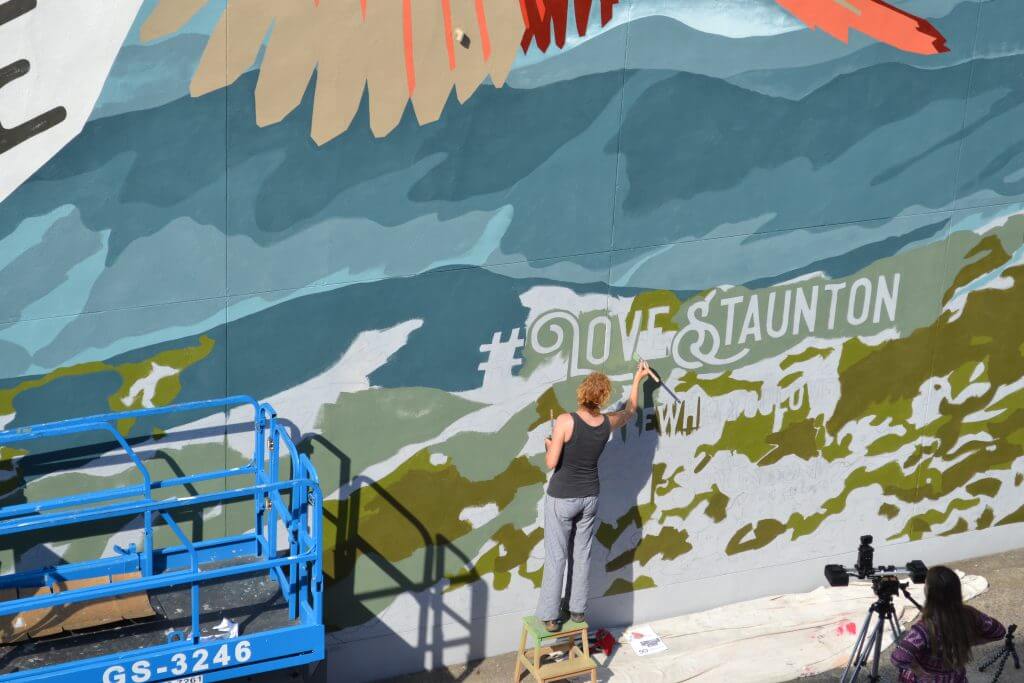
What percentage of your work is actually painting vs. bookkeeping, promotion, planning, etc.?
I spend a lot of time on the logistics of running a business. I have three employees with Pigment, and one is a part-time office manager who handles the books. I am currently looking for an intern for social media assistance as that side of the business is probably my least favorite. Thankfully, I have a strong, enthusiastic client base who continue to amaze me with their support.
When I am on-site working on a large project I tend to focus on the actual work as much as possible. On the ‘You Belong Here’ mural, for example, I have managed to answer emails, create estimates, and make calls before and after the long days of painting.
What’s your style?
Color is paramount! I am constantly amazed at the psychological impact of color and the relationships between hues.
Curiosity and playfulness are also a common thread in my work. When it comes to public work I respect the importance of the interaction of the viewer with the piece and as such my work holds a message of hope, peace, and ideally, truth.
In my personal work, I enjoy painting from life and spending time observing and translating what I see.
Describe your process for creating the design.
My family and I have spent a fair amount of time in Staunton over the last decade. From Mischief & Magic, to visiting friends who live here, to just exploring the area, we have found Staunton to be a treasure of a town.
The pair of cardinals are a nod to our state bird and also a nod to the Virginia is for Lovers campaign that funded this project. Also, I frequently see the most beautiful female cardinal outside of my home studio window and wanted an opportunity to showcase her. The males are lovely too, but why not represent both? The cardinals also serve to add some vibrant color and some stylized lines. I wanted them to lift the banner over the mountains to illustrate that the natural world is offering a message of affirmation.
What message do you hope to portray about Staunton?
I have had a few conversations with folks who have thought the message of ‘You Belong Here’ is a political one, but for me, it’s personal. I was born in Virginia, but we moved every few years. By the time I left for college I had moved eight times. I always longed for a sense of home. Whenever I come back to the area and get the first glimpse of the mountains, I feel like I am home.
I thought about the residents and what would signify a sense of place for them, individually and collectively. I considered those who have lived in the area for generations and those who have ancestors native to this land. Before the buildings and monuments and streets, what would ‘home’ look like? And for those who are new to the area, what would they see that would connect them to the past and provide a sense of place? I kept coming back to the mountains and the phrase ‘you belong here’.
In the last several years especially, I’ve seen such pain in the longing for identity and belonging. There has been such hate and division and such a resistance to listen. My hope through the design and message of this mural is to be a reminder to those who encounter it that, yes, you belong here and also so do your neighbors. We can remind each other of our connectedness instead of our differences.
How did you feel when your piece was selected?
I was so surprised and thrilled to get the opportunity to create this piece for Staunton. My sons were with me when I read the acceptance email and they were confused and a bit concerned about why I was shouting until they realized it was a very good thing.
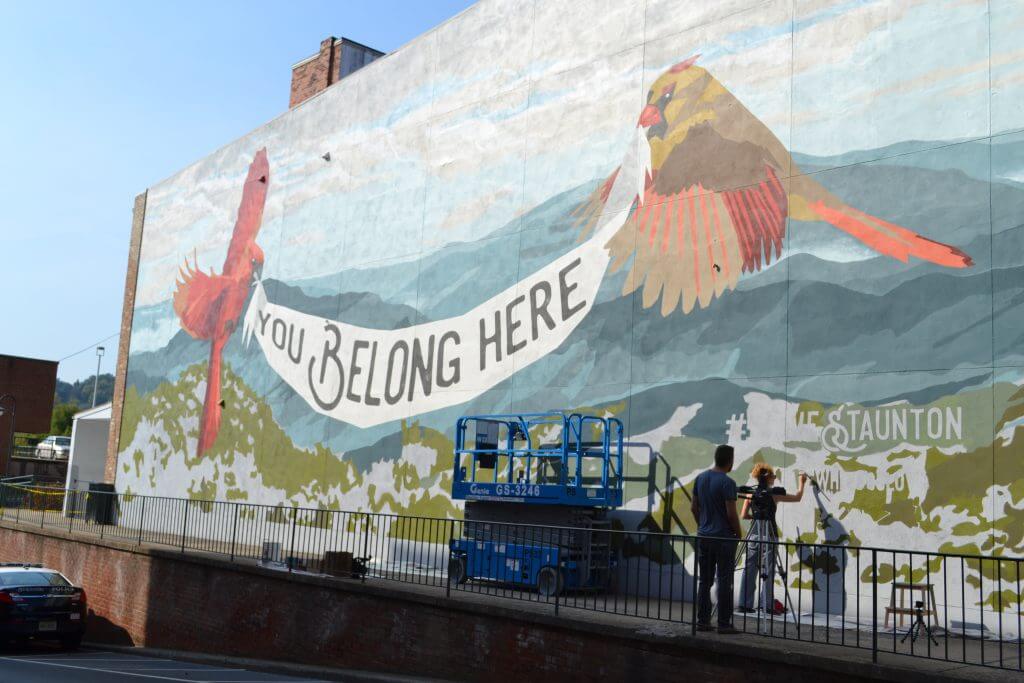
What Steps Are Involved in painting the mural?
Each mural project is unique and has its own set of challenges and difficulties. A wall of this size can take anywhere from a week to several months. So much depends on the condition of the wall, accessibility, and ultimately the design. Because the budget was fixed from the outset I knew how much I could budget for the labor involved. The intricacy of the design was somewhat dictated by the number of hours and the amount of materials allotted, including the lift rental.
I clean and prime each wall and use a high-quality paint which is crucial. Topcoats aren’t needed unless vandalism or weather are concerns.
There are several methods of transferring a design to a wall. I prefer to use a digital projector, which I used on this project. A fair amount of what I do is free-hand as I go and changes need to be made. Sometimes I might incorporate a stencil as well.
I have used everything from extension ladders to boom lifts. Before starting any project I assess the safety concerns and address them. Whether it’s power lines, wasps’ nests, unstable ground, or just being tired, it’s best to deal with it from the outset.
What is your typical daily routine?
I take care of emails and design work early in the morning and then head over the mountain to arrive on-site at 9 a.m. Once on-site, I check in with any assistants and then start setting up my work space. I usually have a list of priorities for the day and I start working down the list. At the end of the day, I break down my work station, clean my brushes and head home. Sometimes I have to swing by my studio to follow up on any projects that need attention.
Do you spend a lot of time fielding questions from passersby when working in a public space?
One of the things I love about creating public art is interacting with folks passing by. Sometimes it can be distracting to the work but I try to make an effort to respond when people take the time to ask a question or make a comment. Usually, I can keep working as I talk but sometimes I take a break to get into a more involved conversation.
What kinds of questions do people walking by ask?
Most people want to know how long something will take or how I get the design so big!
What do people generally think about public art?
The nature of public art is that it is open for conversation and critique. Everyone has an opinion but not everyone shares their opinion. In general, I have found that people welcome public art, especially if it brings a sense of positivity. When public art gets contentious is when it is hurtful or inconsiderate to the audience. Public art can be controversial regardless of intent, which I think is a good thing. When public art carries with it a sense of permanence or an oppressive agenda is when things get ugly.
What do you think are the biggest misconceptions surrounding people who create art for a living?
One misconception I run into a lot is that an artist should be willing to do work for free. We should compensate artists fairly for their work. I wouldn’t create art if I didn’t feel passionate about it, but that doesn’t mean I should allow my work to be devalued because I love what I do. Years ago I committed to pursuing a career as an artist and I am still paying off the student loans. I view myself as successful in that I can provide for my family through my skill and abilities as an artist and designer. That said, I would like to have more time to pursue other interests and spend time with my friends and family. All art requires time, material, space, and a sense of safety. Often I find myself with a few of those elements but not all.
Many people think artists are lazy or disorganized. I’ve found, myself included, that as artists we are always working. Our minds are formulating projects and ideas, our eyes are taking in references and inspiration, our bodies are moving and making constantly.

What will you work on next?
I have several mural projects, a few custom painted floors, and some hand-painted signs lined up for the next few months!
What is your dream project?
My sketchbook is full of ideas for projects I’d love to pursue should I have the resources available. I’d love to create more immersive, experiential art pieces that invite interaction and transformation.
Newsletter Sign-up
Stay up to date on the latest and greatest happening in Staunton.
